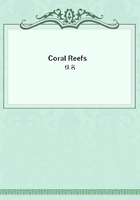
第20章
In the reduction of the chart of Mahlos Mahdoo (Plate II., Figure 4), it was not found easy to define the islets and the little lagoons within each reef, so that the ring-formed structure is very imperfectly shown; in the large published charts of Tilla-dou-Matte, the appearance of these rings, from standing further apart from each other, is very remarkable. The rings on the margin are generally elongated; many of them are three, and some even five miles, in diameter; those within the lagoon are usually smaller, few being more than two miles across, and the greater number rather less than one. The depth of the little lagoon within these small annular reefs is generally from five to seven fathoms, but occasionally more; and in Ari atoll many of the central ones are twelve, and some even more than twelve fathoms deep. These rings rise abruptly from the platform or bank, on which they are placed; their outer margin is invariably bordered by living coral (Captain Moresby informs me that Millepora complanata is one of the commonest kinds on the outer margin, as it is at Keeling atoll.) within which there is a flat surface of coral rock; of this flat, sand and fragments have in many cases accumulated and been converted into islets, clothed with vegetation. I can, in fact, point out no essential difference between these little ring-formed reefs (which, however, are larger, and contain deeper lagoons than many true atolls that stand in the open sea), and the most perfectly characterised atolls, excepting that the ring-formed reefs are based on a shallow foundation, instead of on the floor of the open sea, and that instead of being scattered irregularly, they are grouped closely together on one large platform, with the marginal rings arranged in a rudely formed circle.
The perfect series which can be traced from portions of simple linear reef, to others including long linear lagoons, and from these again to oval or almost circular rings, renders it probable that the latter are merely modifications of the linear or normal state. It is conformable with this view, that the ring-formed reefs on the margin, even where most perfect and standing furthest apart, generally have their longest axes directed in the line which the reef would have held, if the atoll had been bounded by an ordinary wall. We may also infer that the central ring-formed reefs are modifications of those irregular ones, which are found in the lagoons of all common atolls. It appears from the charts on a large scale, that the ring-like structure is contingent on the marginal channels or breaches being wide; and, consequently, on the whole interior of the atoll being freely exposed to the waters of the open sea. When the channels are narrow or few in number, although the lagoon be of great size and depth (as in Suadiva), there are no ring-formed reefs; where the channels are somewhat broader, the marginal portions of reef, and especially those close to the larger channels, are ring-formed, but the central ones are not so; where they are broadest, almost every reef throughout the atoll is more or less perfectly ring-formed. Although their presence is thus contingent on the openness of the marginal channels, the theory of their formation, as we shall hereafter see, is included in that of the parent atolls, of which they form the separate portions.
The lagoons of all the atolls in the southern part of the Archipelago are from ten to twenty fathoms deeper than those in the northern part. This is well exemplified in the case of Addoo, the southernmost atoll in the group, for although only nine miles in its longest diameter, it has a depth of thirty-nine fathoms, whereas all the other small atolls have comparatively shallow lagoons; I can assign no adequate cause for this difference in depth. In the central and deepest part of the lagoons, the bottom consists, as I am informed by Captain Moresby, of stiff clay (probably a calcareous mud); nearer the border it consists of sand, and in the channels through the reef, of hard sand-banks, sandstone, conglomerate rubble, and a little live coral. Close outside the reef and the line joining its detached portions (where intersected by many channels), the bottom is sandy, and it slopes abruptly into unfathomable depths. In most lagoons the depth is considerably greater in the centre than in the channels; but in Tilla-dou-Matte, where the marginal ring-formed reefs stand far apart, the same depth is carried across the entire atoll, from the deep-water line on one side to that on the other. I cannot refrain from once again remarking on the singularity of these atolls,--a great sandy and generally concave disc rises abruptly from the unfathomable ocean, with its central expanse studded and its border symmetrically fringed with oval basins of coral-rock, just lipping the surface of the sea, sometimes clothed with vegetation, and each containing a little lake of clear water!
In the southern Maldiva atolls, of which there are nine large ones, all the small reefs within the lagoons come to the surface, and are dry at low water spring-tides; hence in navigating them, there is no danger from submarine banks. This circumstance is very remarkable, as within some atolls, for instance those of the neighbouring Chagos group, not a single reef comes to the surface, and in most other cases a few only do, and the rest lie at all intermediate depths from the bottom upwards. When treating of the growth of coral I shall again refer to this subject.
Although in the neighbourhood of the Maldiva Archipelago the winds, during the monsoons, blow during nearly an equal time from opposite quarters, and although, as I am informed by Captain Moresby, the westerly winds are the strongest, yet the islets are almost all placed on the eastern side of the northern atolls, and on the south-eastern side of the southern atolls.